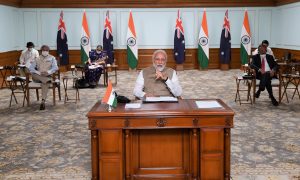On June 4, Indian Prime Minister Narendra Modi and his Australian counterpart Scott Morrison conducted a “virtual summit” in lieu of Morrison’s planned visit to Delhi, which was cancelled due to the ongoing pandemic. The summit was notable for the announced elevation of the India-Australia relationship to a “Comprehensive Strategic Partnership.” A key component of the upgrade is a mutual commitment toward maritime cooperation in the Indo-Pacific, as espoused in a joint “Shared Vision” declaration by the leaders. The declaration, along with a key accompanying agreement, sets the stage for deeper maritime security cooperation between the two sides.
As two democratic middle powers connected by the Indian Ocean, maritime security is an integral plank of the India-Australia relationship. To that end, their maritime outlooks are already somewhat aligned. Both have embraced the “Indo-Pacific” framework, albeit with divergent geographical understandings (Australia’s definition clearly denotes the eastern Indian Ocean as the eastern boundary whereas India envisions the zone of engagement extending to Africa). Both are also partners (along with United States and Japan) in the “Quad” group, largely seen as a kind of Indo-Pacific alliance. At a bilateral level, Australia’s seminal 2017 Foreign Policy White Paper recognizes India as the “pre-eminent maritime power among Indian Ocean countries.”
Despite this congruence, however, as geopolitical developments pose ever more complex challenges, there is perhaps a renewed impetus for Delhi and Canberra to intensify engagement in the Indo-Pacific toward mutual maritime security interests. Accordingly, the recent Shared Vision comes at an opportune moment and warrants attention.
The Shared Vision declaration, albeit brief, contains points of note with salient implications for maritime security. Two such points, regarding the medium and (possible) forms of cooperation, are as follows.
First, the declaration specifically mentions an intent to develop the “Indo-Pacific Oceans Initiative” (IPOI). Modi first proposed the IPOI at the 2019 East Asia Summit (EAS) as a collaborative undertaking for a “safe, secure, and stable maritime domain.” In that speech, he outlined that the “security pillar” of the IPOI could begin at an India-Australia-Indonesia trilateral EAS workshop on maritime security (which was later held in India in February 2020). Modi also particularly recognized Australia’s “positive outlook” toward the IPOI. It therefore appears that going forward, the IPOI could be the new apparatus for Indo-Australian maritime security cooperation. While it is yet early days and details are scant, it is obvious that other countries will be co-opted into the initiative. Indonesia, as co-host of the EAS workshop, seems a likely partner. Notably, when Modi visited Jakarta in 2018, he jointly signed a similar Shared Vision declaration with Indonesian President Joko Widodo (one that is much more expansive in scope than the India-Australia version).
Second, the statement notes that maritime cooperation will extend to all levels — bilateral, regional, multilateral, and minilateral. Of these, security collaboration at the bilateral and multilateral level is already underway. The bilateral AUSINDEX naval exercise, initiated in 2015, completed its third iteration last year. Multilaterally, Australia has also participated in multiple editions of the Indian Navy’s flagship MILAN exercise. The notion of minilateral cooperation remains one that could potentially be explored, especially in subregions of mutual interest (such as in the Bay of Bengal), with perhaps one to two other partners. An example of this could be Australia’s inclusion in the India-U.S.-Japan trilateral Malabar exercise, in which Canberra last participated in a minor capacity in 2007. As of this writing, there is speculation that India will include Australia in future editions. Beyond the Malabar exercise, an entirely new minilateral exercise could also be initiated (as India did in 2019 with Singapore and Thailand).
Finally, alongside the vision declaration and comprehensive partnership, the two sides also signed a few agreements and memoranda of understanding pertaining to specific areas of cooperation such as cyber threats and science and technology. Among these was the much anticipated Mutual Logistics Support Agreement (MLSA), which enables maritime security specifics such as port visits and use of bases, as well as cooperation in areas such as humanitarian assistance and disaster relief. The MLSA will likely foster increased and intensified cooperation and analysts have already identified possible zones of action for such cooperation, such as joint operations in respective island territories.
In conclusion, the elements described above, taken together, are a first step, both rhetorical and regulatory, toward a deeper India-Australia maritime security partnership in the Indo-Pacific. It now remains to be seen if Modi and Morrison will walk the talk.
Ankush Wagle is a graduate student of public policy and Li Ka-Shing scholar at the Lee Kuan Yew School of Public Policy, National University of Singapore (NUS). He previously worked as a research analyst at the Institute of South Asian Studies (ISAS), an autonomous research institute at NUS, where his research focused on the international relations between South and Southeast Asia, and Indo-Pacific affairs.

































